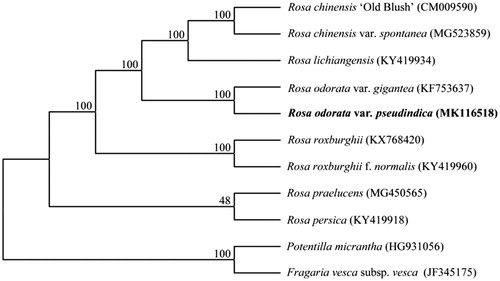Abstract
Rosa odorata var. pseudindica is a world-famous Chinese Old Rose endemic to the northwest of Yunnan province (China). In this study, the complete plastid genome of R. odorata var. pseudindica was characterized and assembled using a high-throughput sequencing method. The complete plastid genome is a typical quadripartite circular molecule of 156,652 bp length, including a large single-copy region of 85,785 bp and a small single-copy region of 18,761 bp separated by two inverted repeat regions of 26,053 bp. Totally 130 genes were identified, including 85 protein-coding genes (PCG), 37 transfer RNA genes, and 8 ribosomal RNA genes. The phylogenetic analysis revealed that R. odorata var. pseudindica and R. odorata var. gigantea formed an independent clade with a 100% bootstrap support.
Rosa odorata (Andrew) Sweet is one of the seven major wild ancestors of modern roses, mainly contributing excellent traits of large flower and unique tea scent (Wylie Citation1954). In the 1800s, four ‘Stud Chinas’ were introduced from China into Europe, and two of which were tea roses derived from R. odorata (Hurst Citation1941). Rosa odorata has been listed as a Class III protected plant (Fu Citation1992), rare and endangered species in Chinese Rare and Endangered Protective Plants List (The National Environment Protection Agency, Institute of Botany CAS Citation1987). Rosa odorata contains four varieties: R. odorata var. odorata, R. odorata var. erubescens (Focke) T. T. Yu & T. C. Ku, R. odorata var. pseudindica (Lindley) Rehder, and R. odorata var. gigantea (Crépin) Rehder & E. H. Wilson (Ku and Robertson Citation2003). Rosa odorata var. pseudindica is identified with double flowers, yellow or orange petals, and rich tea-scented fragrance endemic to northwest Yunnan (China) as an important Chinese Old Rose (Wang Citation2015). In this paper, the complete plastid genome of R. odorata var. pseudindica (GenBank Accession Number: MK116518) was characterized based on the Illumina next-generation sequencing techniques. The complete plastid genome research about this important germplasm resource will facilitate the conservation and breeding of modern roses, and will also be useful for the phylogenetic study of this plant and the genus Rosa.
Fresh leaves of R. odorata var. pseudindica were collected from Lijiang (Yunnan, China; 27°16′002″ N, 99°28′45″ E). Voucher specimen was deposited at the Herbarium of KUN. Total genomic DNA was extracted using the modified CTAB method (Doyle and Doyle Citation1987). Reads of the plastid genome were assembled using CLC Genomic Workbench v10 (CLC Bio., Aarhus, Denmark). All the contigs were checked against the reference genome of R. chinensis var. spontanea (MG523859) using BLAST (https://blast.ncbi.nlm.nih.gov/) and aligned contigs were oriented according to the reference genome. The complete plastid genomes were then constructed using Geneious v4.8.5 (Biomatters Ltd., Auckland, New Zealand) and was automatically annotated using DOGMA (http://dogma.ccbb.utexas.edu/). To identifying the phylogenetic position of R. odorata var. pseudindica, 11 plastid genomes of Rosaceae were aligned using the online program MAFFT (https://mafft.cbrc.jp/alignment/server/index/index.html), and the maximum likelihood (ML) tree was then conducted by MEGA v7.0 (Kumar et al. Citation2016).
The complete plastid genome of R. odorata var. pseudindica represents a typical quadripartite circular molecule with 156,652 bp in length. It is composed by a large single-copy (LSC) region of 85,785 bp, a small single-copy region of 18,761 bp, and a pair of IR regions of 26,053 bp. The genome encodes 130 genes, including 85 PCG genes, 37 tRNA genes, and 8 rRNA genes. Fourteen genes contain one intron and two genes contain two introns. Gene infA was identified in the LSC region, and ψycf15 pseudogene was present in the IR regions due to the presence of seven stop codons in the gene sequence. The overall GC content of R. odorata var. pseudindica plastid genome is 37.2%.
To investigate the phylogenetic position of R. odorata var. pseudindica, eight published plastid genomes of the genus Rosa were used to construct a phylogeny tree, using Potentilla micrantha (HG931056) and Fragaria vesca subsp. vesca (JF345175) in Rosaceae as the outgroups. The results showed that R. odorata var. pseudindica and R. odorata var. gigantea formed an independent clade with a 100% bootstrap support, which was in accordance with the previous result that R. odorata var. gigantea was the maternal parent of the other three double-petals varieties of R. odorata () (Meng et al. Citation2011).
Acknowledgements
We appreciate the Laboratory of Molecular Biology in the Germplasm Bank of Wild Species in Southwest China, Kunming Institute of Botany, Chinese Academy of Sciences for providing an experimental platform.
Disclosure statement
No potential conflict of interest was reported by the authors.
Additional information
Funding
References
- Doyle JJ, Doyle JL. 1987. A rapid DNA isolation procedure for small quantities of fresh leaf tissue. Phytochem Bull. 19:11–15.
- Fu LG. 1992. China plant red data book: rare and endangered plants. Beijing: Science Press.
- Hurst CC. 1941. Notes on the origin and evolution of our garden roses. J Roy Hort Soc. 66:242–250.
- Ku TC, Robertson KR. 2003. Rosa. In: Wu ZY, Raven PH, editors. Flora of China. Vol 9. Beijing and St. Louis: Science Press and Missouri Botanical Garden Press; p. 296–339.
- Kumar S, Stecher G, Tamura K. 2016. MEGA7: molecular evolutionary genetics analysis version 7.0 for bigger datasets. Mol Biol Evol. 33:1870–1874.
- Meng J, Marie FD, Zhang LB, Li DZ, Yi TS. 2011. Untangling the hybrid origin of the Chinese tea roses: evidence from DNA sequences of single-copy nuclear and chloroplast genes. Plant Syst Evol. 297:157–170.
- The National Environment Protection Agency, Institute of Botany CAS. 1987. Directory of rare and endangered protected plants in China. Beijing: Science Press.
- Wang GL. 2015. Old roses in China. Beijing: Science Press.
- Wylie AP. 1954. The history of garden roses. J Roy Hortic Soc. 79:555–571.

